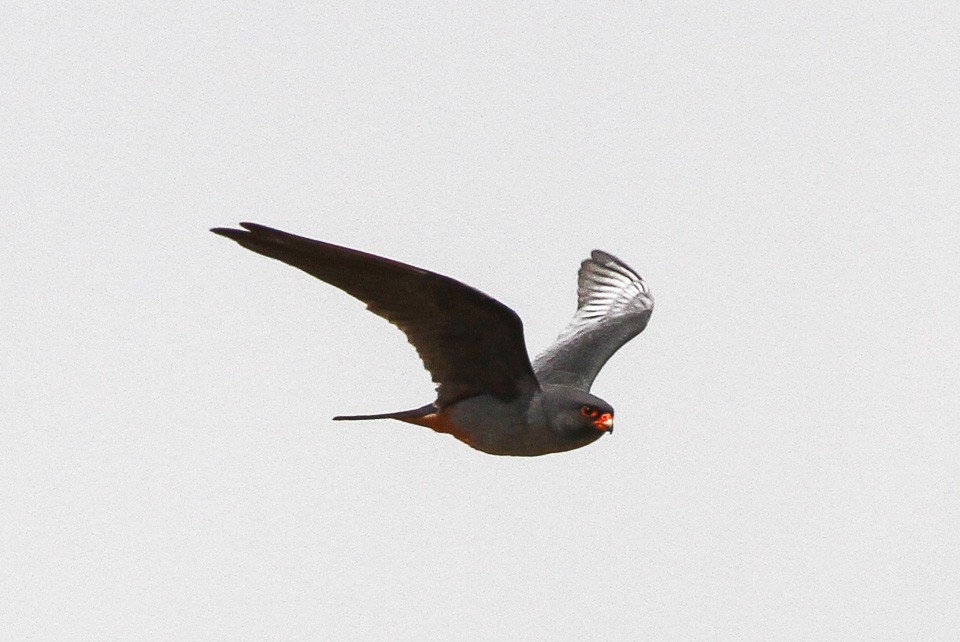Red-footed Falcon
A species of True Falcons Scientific name : Falco vespertinus Genus : True Falcons
Red-footed Falcon, A species of True Falcons
Botanical name: Falco vespertinus
Genus: True Falcons
Content
Description General Info
Description
It is a medium-small, long-winged species. The adult male is all blue-grey, except for his red undertail and legs; its underwings are uniformly grey. The female has a grey back and wings, orange head and underparts, and a white face with black eye stripe and moustaches. Young birds are brown above and buff below with dark streaks, and a face pattern like the female. Red-footed falcons are 28–34 cm (11–13 in) in length with a wingspan of 65–75 cm (26–30 in). The average mass is 155 g (5.5 oz). 
Size
32 cm
Colors
Black
Red
Gray
White
Blue
Orange
Life Expectancy
5 years
Nest Placement
Building
Feeding Habits
Red-footed Falcon consume a mixed diet, including insects, amphibians, and small vertebrates. They exhibit hover hunting and perform steep dives to catch prey. Distinctively, the youngest nestlings are prioritized for frequent, varied feeding, with diet shifting as they age.
Habitat
Red-footed Falcon mainly inhabits open regions such as steppes and wooded steppes from Eastern Europe to Central Asia, favoring grasslands, agricultural terrains, and areas with scattered trees like orchards. These habitats are typically lowland, though they can reach 1500 m elevation. Migration sees red-footed Falcon in African grasslands, savannas, and urban scrublands, often roosting in eucalypt groves.
Dite type
Carnivorous
General Info
Feeding Habits
Bird food type
Behavior
This falcon is a colonial breeder, reusing the old nests of corvids, such as rooks. It lays two to four eggs. Its maximum lifespan is 13.25 years in the wild and 18 years in captivity. 
Distribution Area
The main areas of European distribution are in southern Russia and Ukraine . The species occurs in large numbers in Hungary, Romania and Serbia . Smaller populations exist in Italy, Bulgaria and Moldova, in Austria , Slovakia and in Belarus . The red-footed falcon also breeds irregularly in the Czech Republic and in the Baltic States , occasionally also in Germany . In Asia, the breeding occurrences run in a relatively narrow band somewhat south of the taiga eastwards to the upper Lena , where they touch the range of the sister species Falco amurensis east of the Baikal . The northern border lies between the 63 ° and 58 ° north latitude, the south border around 45 ° north latitude. It runs along the north slope of the Altai and then westward follows the transition of open pine forests into the treeless steppe areas of Central Asia. Further to the west, the breeding areas on the lower reaches of the Volga and on the north coast of the Caspian Sea reach Europe. The southernmost occurrences are in the steppe areas north of the Caucasus and in South Georgia . Some isolated breeding areas are located in northern Turkey. The red-footed falcon winters in southern and eastern Africa. 
Species Status
The global population of red-footed falcon is estimated to be between 300,000-800,000 individuals, with 26,000 to 39,000 pairs in Europe. Most of the population breeds in the steppe grasslands of Russia and central Asia, although a significant amount also breeds in the Ukraine, Romania and Hungary. In 2005, the population in Hungary was estimated to be between 700 and 800, showing a steady decline. Red-footed falcons can be considered as a classic umbrella species because they affect other species living in the community. They play a popular role in the Natura 2000 designation process. Therefore, locating their breeding sites or creating breeding sites by providing artificial colonies has additional conservation and socio-economic benefits for both wildlife and the local human population. 
Scientific Classification
Phylum
Chordates Class
Birds Order
Diurnal Birds of Prey Family
Falcons and caracaras Genus
True Falcons Species
Red-footed Falcon 